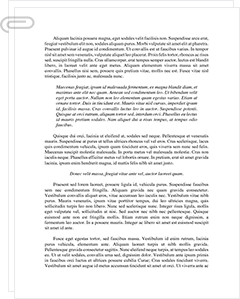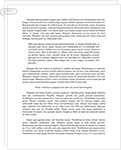 Study Document
Study Document
Food Safety Critical Analysis Essay
Pages:4 (1443 words)
Sources:4
Subject:Health
Topic:Food Safety
Document Type:Essay
Document:#43970248
Food
The case of Stephanie Smith is certainly alarming, and having familiarized myself with both the ammonia in hamburger issue and the pink slime issue, I will argue that my faith in the USDA and FDA to provide protection to American consumers in terms of the food they eat is sorely lacking. I understand the reality that I have personally not become sick from eating food in America, but that does not mean that the system is working well. By looking at the history of the system, I feel that many of the issues we have today represent a shift away from the foundations of the system.
Required reading on this issue is Upton Sinclair's The Jungle, which detailed the practices of the Chicago meatpacking industry. This book was the first to bring many of these issues to light. In those days, it was not uncommon for people to become sick from the food they ate, and meat was an especially egregious culprit. The book caused public uproar that reached all the way to the White House.
The result of this scandal was the creation of the modern system of guaranteeing food safety. The government created the Food and Drug Administration's precursor body to look at the food industry and ensure that foods sold were healthy; the "drugs" part came later in response to similar issues with health tonics and the like. The USDA is also involved in the food system, especially at the agricultural level. In general, the system was designed to ensure that safety of the nation's food supply. In that sense, it is important to understand what the food safety system is and what it is not. The food safety system is only concerned with safety, not with quality. There is a difference between the two. Most people are naturally revolted by things like pink slime, but if it is healthy to be consumed, that is all it needs in order to gain approval. There is nothing in the food safety guidelines that protect Americans from eating crap.
The Food Safety System
Since the food safety system exists to ensure that integrity of our food system, we need to have a better understanding of how this works. One would like to think that the system is less necessary today than at the time of The Jungle, but that is not the case. Most businesses engaged in food production are businesses first and foremost. Many, like Cargill, Tyson and others, are oriented towards maximizing shareholder wealth. They are content to do whatever they can to lower prices. They do this because consumers are generally unaware of how their food is produced, and government is only concerned with whether or not the food will make you sick.
The food safety system is primarily concerned with high risk products. Most new food products that are introduced will not need to go through a rigorous approval process. If they came up with Pizza-Flavored Oreos tomorrow, they would not need prior approval from the FDA to be sold. Only when high risk products are launched do they need to be subject to investigation. For meat, this tends to be at the USDA level, especially for meat that is minimally-processed. Hamburgers are not generally tested prior to their being sold to the public. This is not good practice. First, hamburgers are meat product, and ground meat is considered more dangerous than other meats because more of the surface area of the meat has been exposed to air, which increases the risk of bacterial infection -- e.coli being a bacterium.
The lack of testing as a routine practice comes about from a core underlying philosophy of the regulatory bodies that ensure our food safety. They seek to work with business to maximize efficiency. On some levels, this is reasonable -- lab-testing every burger is impossible, and largely pointless -- but there is a point at which some safeguards need to be developed. Generally, these safeguards are in the form of best practices, which are outlined for the slaughter of the cattle onward. These practices are intended to minimize the risk but they cannot eliminate it, especially in the case of meat. To streamline the production process while maintaining minimal levels of risk, ammonia is added to kill bacteria. If this process fails, then the consumer…
Sample Source(s) Used
References
Karnowski, S. (2010). Stephanie Smith, Cargill settle on E. Coli case after NYT story about tainted meat. Huffington Post. Retrieved April 28, 2014 http://www.huffingtonpost.com/2010/05/12/stephanie-smith-cargill-s_n_574290.html
Sinclair, U. (1906). The Jungle
Related Documents
 Study Document
Study Document
Food Safety
Food Safety Manual Food Safety Purpose and Scope of Manual Foundations for Use Safe Food Handling The Flow of Food Purchasing and Receiving Storage Preparation Service Hazard Analysis Critical Control Point (HACCP) Employee Food Safety Training Food Safety Manual Nearly 1 in 6 Americans will become sick due to foodborne illness each year and of these, 3,000 will die (CDC, 2011). Since 1997 the number of Escherichia coli has been cut in half, but the prevalence of Salmonella infections has remained stable. Salmonella
 Study Document
Study Document
Food Safety and Food
Validation of Commercial Baking as an Effective Step to Control/Inactivate Salmonella in Baked Products Major findings, analysis and conclusions Description of the baking industry and baking emphasis in the United States. Purpose and structure of importance Description of the problem being addressed and its importance to the practice of applied food safety Process of Consultation Outline how the client (ABA) will be engaged and carefully define the problem Identification of key stakeholders Overview and feedback of findings and
 Study Document
Study Document
Canadian Food Safety: A Wider
Holley's (Chase, 2010) on grounds of dereliction of duty. If the State 'got paid' the same regardless of how many violations it prosecuted, that second dimension of moral hazard would overlap the primary incentive for producers to cheat. Adverse selection is often considered a result, rather than a cause of moral hazard, where offering a risk-bearing product creates incentive for demand by the riskiest consumers. Obvious modern examples include offering
 Study Document
Study Document
The Final Research Paper for Food Safety
causes of foodborne illnesses include inadequate hand washing at any stage including the consumer, cross-contamination such as using the same cutting board for meat as cheese, improper storage temperatures such as a refrigerator that is not set cold enough, improper cooking temperatures, particularly regarding meat, the contamination of food by animal waste, which generally occurs in factory food production, and the contamination of soil or water supplies from natural
 Study Document
Study Document
Food and Beverage Industry Analyzing
Wal-Mart specifically is pioneering the development of Radio Frequency Identification (RFID) projects with up to two thousand of its key suppliers today (Kumar, 2007). The goal of this pilot is to enable food and beverage suppliers to coordinate more effectively with Wal-Mart on mixed pallet mode shipping of products (Kumar, 2007). This is critical for Wal-Mart from the standpoint of supporting their expansion strategies into smaller, more diverse stores
 Study Document
Study Document
Contemporary Ethics Analysis of Genetic Engineering and Genetically Modified Organisms...
Ethics Analysis of Genetic Engineering and Genetically Modified Organisms Custom research material provided by Stud ent Network Resources, Inc. Ethics and Morality Contemporary Ethics Analysis of Genetic Engineering and Genetically Modified Organisms Ethics and Morality According to the article "Can a genetically-modified organism-containing diet influence embryo development? A preliminary study on pre-implantation mouse embryos," "Millions of test is used every year for a wide variety of scientific and medical purposes. This article, discusses issues



